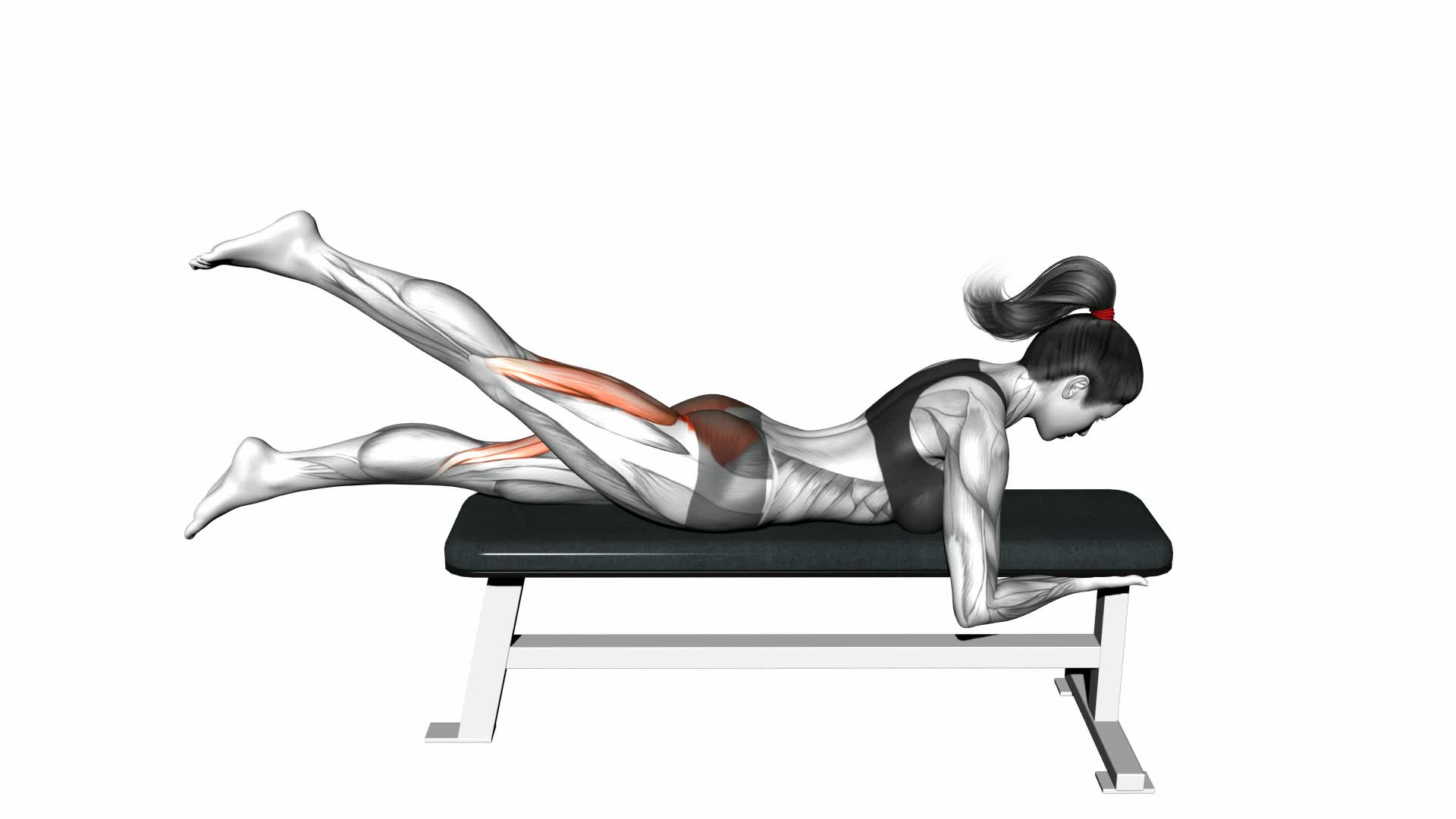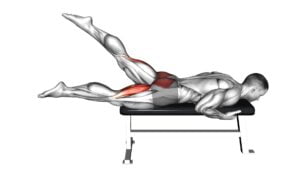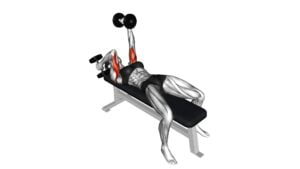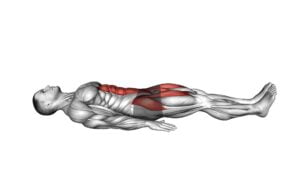Lying Alternate Hip Extension – Video Exercise Guide & Tips

Are you looking for an effective exercise to strengthen your hips? Look no further than the lying alternate hip extension.
Watch This Exercise Video
This video exercise guide will show you the proper form and provide helpful tips to maximize your results.
Whether you're a beginner or a fitness enthusiast, there are modifications available for every fitness level.
Get ready to challenge yourself and take your hip strength to the next level with this powerful exercise.
Key Takeaways
- Lying Alternate Hip Extension improves hip and glute strength and enhances hip range of motion.
- Proper form and avoiding mistakes such as using excessive momentum and not engaging glutes and hamstrings properly are important for effective execution.
- Harmful exercise techniques include poor form leading to injuries, overtraining causing overuse injuries, and straining joints due to incorrect posture.
- Modifications for different fitness levels include increasing range of motion, adding resistance, performing on unstable surfaces, and adapting for injuries or limitations.
Benefits of Lying Alternate Hip Extension
The benefits of lying alternate hip extension include improved hip and glute strength. Hip mobility is crucial for overall movement and functionality, and incorporating this exercise into your workout routine can help enhance your hip range of motion. By performing lying alternate hip extensions, you activate your glute muscles, which play a significant role in hip extension and stabilization.
To incorporate lying alternate hip extension into your workout routine, start by lying flat on your back with your knees bent and feet flat on the floor. Place your hands by your sides for support. Begin by lifting one leg up towards the ceiling, keeping your knee bent at a 90-degree angle. Slowly lower the leg back down to the starting position and repeat on the other side. Aim for 2-3 sets of 10-12 repetitions on each leg.
It is important to maintain proper form throughout the exercise. Keep your core engaged and avoid arching your lower back. Focus on using your glute muscles to lift and lower your leg, rather than relying on momentum.
Proper Form for Lying Alternate Hip Extension
To perform the lying alternate hip extension exercise with proper form, make sure to engage your core and avoid arching your lower back. Here are some tips to help you perform this exercise correctly:
- Start by lying flat on your stomach with your legs extended and your arms resting alongside your body. Engage your core muscles by pulling your belly button towards your spine.
- Lift one leg off the ground, keeping it straight and raising it as high as you comfortably can without straining. As you lift your leg, focus on squeezing your glutes to engage the hip extensor muscles. Lower your leg back down to the starting position with control.
- Repeat the movement on the opposite leg. Remember to maintain proper alignment throughout the exercise by keeping your hips and pelvis stable. Avoid any excessive twisting or rotating.
- Perform the exercise in a slow and controlled manner to maximize muscle activation and prevent injury.
By performing the lying alternate hip extension exercise with proper form, you can reap the benefits of increased hip strength, improved stability, and enhanced athletic performance.
Common Mistakes to Avoid
To ensure you perform the lying alternate hip extension correctly and avoid any potential harm, it's important to be aware of common mistakes to avoid.
One common mistake is using excessive momentum to lift your legs, which can strain your lower back and diminish the effectiveness of the exercise.
Another mistake isn't engaging your glutes and hamstrings properly, which can lead to compensatory movements and reduced muscle activation.
Harmful Exercise Techniques
Avoiding harmful exercise techniques is crucial for maximizing your workout and preventing injuries. Here are three common mistakes to avoid:
- Poor form: Maintaining proper form is essential to prevent injuries. Make sure to use the correct posture and technique for each exercise, focusing on engaging the targeted muscles and avoiding unnecessary strain on joints.
- Overtraining: Pushing yourself too hard without giving your body enough time to recover can lead to overuse injuries. Listen to your body and incorporate rest days into your workout schedule to allow for proper recovery.
- Ignoring alternative exercises: If you have a pre-existing injury or condition that restricts certain movements, it's important to find alternative exercises that work the same muscle groups without causing further harm. Consult with a fitness professional or physical therapist to find suitable alternatives.
Proper Form Demonstration
Maintaining proper form is crucial for maximizing your workout and preventing injuries, so let's now address the common mistakes to avoid when demonstrating proper form for the Lying Alternate Hip Extension exercise.
When performing this exercise, it's important to keep your core engaged and your back flat on the ground. Avoid lifting your hips too high or arching your back, as this can strain your lower back and diminish the effectiveness of the exercise.
Another common mistake is letting your knees collapse inward instead of keeping them in line with your hips and ankles.
By maintaining proper form, you'll experience the benefits of this exercise, such as strengthening your glutes, hamstrings, and lower back, while also improving your stability and balance.
Modifications for Different Fitness Levels
For varying fitness levels, you can make modifications to the lying alternate hip extension exercise. Whether you're a beginner looking to build strength or an advanced athlete seeking a challenge, here are some options to consider:
- Progression options for lying alternate hip extension:
- Increase the range of motion by extending the leg further back.
- Add resistance by using ankle weights or resistance bands.
- Perform the exercise on an unstable surface, such as a stability ball or foam pad, to engage more muscles for balance and stability.
- Adaptations for individuals with injuries or limitations:
- If you have knee pain, try performing the exercise with a smaller range of motion or with a bent knee.
- For individuals with lower back issues, place a towel or small cushion under the lower back for added support.
- If you have wrist or shoulder problems, perform the exercise with your forearms on the ground instead of your hands.
By modifying the lying alternate hip extension exercise, you can tailor it to your fitness level and accommodate any injuries or limitations you may have.
Remember to always listen to your body and consult with a healthcare professional before starting any new exercise program.
Tips for Maximizing Results
To maximize your results, it's important that you consistently challenge yourself and push your limits during the lying alternate hip extension exercise. Here are some advanced techniques for the lying alternate hip extension that can help you take your workout to the next level.
Firstly, you can increase the resistance by using ankle weights or resistance bands. This will add an extra challenge to your muscles and help you build strength and endurance.
Secondly, you can incorporate tempo variations into your routine. For example, you can perform the exercise at a slower pace, focusing on the mind-muscle connection and fully engaging your glutes. Alternatively, you can try explosive movements, performing the exercise with a quick and powerful extension.
Another tip is to incorporate the lying alternate hip extension into supersets or circuits. By combining it with other exercises, you can create a more challenging and intense workout. This won't only maximize your results but also save time by working multiple muscle groups simultaneously.
Lastly, make sure to maintain proper form throughout the exercise. Keep your core engaged, your spine neutral, and avoid arching your back. This will ensure that you're targeting the right muscles and minimizing the risk of injury.
Incorporating these techniques into your lying alternate hip extension routine will help you effectively challenge your body and maximize your results. Remember to listen to your body and gradually increase the intensity as you progress. Happy exercising!
Variations to Add Challenge
To add challenge to your lying alternate hip extension exercise, try incorporating these variations:
- Increase resistance: Place a resistance band around your ankles or use ankle weights to add extra resistance to your hip extensions. This will help strengthen your glutes and hamstrings even more.
- Elevated feet: Elevating your feet on a bench or step will increase the range of motion and engage your glutes and hamstrings more effectively. This advanced modification will intensify the exercise and provide a greater challenge for your muscles.
- Single-leg hip extensions: Instead of performing the exercise with both legs, try doing it with one leg at a time. This will require more stability and activate your glutes and hamstrings more intensely. It's an advanced technique that will further challenge your muscles.
By incorporating these advanced modifications and techniques into your lying alternate hip extension exercise, you can take your workout to the next level.
Remember to listen to your body and start with lighter resistance or lower elevation if you're new to these variations. As you become more comfortable and stronger, gradually increase the intensity to continue challenging your muscles and maximizing your results.
Frequently Asked Questions
How Many Sets and Repetitions Should I Perform for Lying Alternate Hip Extensions?
To determine the number of sets and repetitions for lying alternate hip extensions, consider your fitness goals and current fitness level.
Generally, it's recommended to perform 2-4 sets of 10-15 repetitions per leg.
However, if you're a beginner, start with lower numbers and gradually increase as you get stronger.
Remember to listen to your body and consult a fitness professional for personalized guidance.
Can Lying Alternate Hip Extensions Help With Lower Back Pain?
Lying alternate hip extensions can be effective for improving hip mobility, which may help with lower back pain. This exercise targets the glute muscles and can strengthen them, providing support to the lower back.
It's important to note that while this exercise can be beneficial, it should be done in conjunction with other exercises that target the core and back muscles for a comprehensive approach to lower back pain relief.
Are There Any Equipment or Props That Can Be Used to Enhance the Lying Alternate Hip Extension Exercise?
To enhance the lying alternate hip extension exercise, you can add resistance bands or ankle weights. These props provide additional resistance, making the exercise more challenging and effective.
Resistance bands can be placed around your ankles or thighs to increase the tension on your hip muscles.
Ankle weights can be attached to your ankles to add extra weight and resistance.
Both options can help you strengthen your hip muscles and improve the overall effectiveness of the exercise.
Is It Necessary to Warm up Before Performing Lying Alternate Hip Extensions?
Yes, it's necessary to warm up before performing lying alternate hip extensions. Incorporating this exercise into a dynamic warm-up routine has several benefits. It helps increase blood flow to the muscles, improves joint mobility, and prepares your body for more intense movements.
For beginners or individuals with limited mobility, you can modify the exercise by using a resistance band or starting with smaller movements. It's important to consult with a fitness professional for proper modifications and technique.
Can Lying Alternate Hip Extensions Be Included in a Full-Body Workout Routine?
Yes, lying alternate hip extensions can be included in a full-body workout routine. They're a great exercise for injury prevention and muscle activation.
By targeting the hip muscles, they help stabilize the lower body and improve overall strength. Incorporating them into your routine can also enhance your performance in other exercises.
Remember to maintain proper form and start with lighter weights before progressing. Consult with a fitness professional for personalized advice.
Conclusion
In conclusion, the lying alternate hip extension is a beneficial exercise for improving hip strength and stability. By maintaining proper form and avoiding common mistakes, individuals can maximize their results.
Modifications can be made to accommodate different fitness levels, and variations can be added to increase the challenge.
By incorporating this exercise into a well-rounded fitness routine, individuals can enhance their overall lower body strength and performance.

Author
Years ago, the spark of my life’s passion ignited in my mind the moment I stepped into the local gym for the first time. The inaugural bead of perspiration, the initial endeavor, the very first surge of endorphins, and a sense of pride that washed over me post-workout marked the beginning of my deep-seated interest in strength sports, fitness, and sports nutrition. This very curiosity blossomed rapidly into a profound fascination, propelling me to earn a Master’s degree in Physical Education from the Academy of Physical Education in Krakow, followed by a Sports Manager diploma from the Jagiellonian University. My journey of growth led me to gain more specialized qualifications, such as being a certified personal trainer with a focus on sports dietetics, a lifeguard, and an instructor for wellness and corrective gymnastics. Theoretical knowledge paired seamlessly with practical experience, reinforcing my belief that the transformation of individuals under my guidance was also a reflection of my personal growth. This belief holds true even today. Each day, I strive to push the boundaries and explore new realms. These realms gently elevate me to greater heights. The unique combination of passion for my field and the continuous quest for growth fuels my drive to break new ground.



